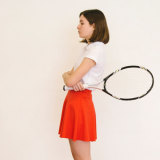Between the cricket, Wimbledon and the Women's World Cup in the last month, our screens have been filled with toned bodies achieving impossible feats of fitness and sporting finesse.
If all this is inspiring you to get fit, or get fitter, but the task feels daunting and the sofa rather more appealing, have faith: it's all about finding the right activity for you. Beginning a new five-part weekly series, helping you enjoy better health and well-being at every stage of life, leading experts reveal the best sports to try for your age group.
In your 20s, aim for a healthy addiction to exercise.Credit:Stocksy
20s
Sports to try: sprinting, circuits, rowing
For many, these are also the years for partying and eating what you want – but it should be about building foundations for future health and fitness, says Professor Greg Whyte, sports scientist and celebrity training coach.
Tennis is a good sport for your time-poor 30s.Credit:Stocksy
"In your 20s you are at the peak of your powers. This age needs to be about building strength and muscle – because this will biologically start to decline when you hit 35 – as well as cardiovascular fitness."
Building muscle now helps develop a good metabolic rate, protecting against weight gain, and will also protect your bones and joints as you age, says Matt Roberts, personal trainer and author of Younger, Fitter, Stronger: The Revolutionary 8-Week Fitness Plan for Men. "Research shows collagen is more readily produced when you have more activated muscle mass, so it's anti-ageing."
Prof Whyte recommends 30 minutes of moderate physical activity most days of the week, including strength endurance classes, such as circuits, and cardio-vascular activities such as swimming, running, cycling or rowing. This is the decade to find exercise you love: "You want to build up a healthy addiction to exercise."
30s
Try: squash, tennis, pelvic floor exercises
Busy, time-poor and likely to be spending more time in a sedentary job, this is a time to integrate energetic, multitasking sports into your routine, says Roberts.
"Tennis or squash played at high intensity is good for getting a muscular, cardiovascular, flexibility and co-ordination workout along with a stress release within one 45-60 minute commitment weekly."
He also advises "exercise snacking" – running home or doing a short, 25-minute run in your lunch hour.
This is the decade that children are most likely to come along, so women should be paying attention to pelvic floors with planks, side planks, pilates and yoga. "Try the bridge – lying on your back with your feet flat on the floor, knees bent and doing pelvic lifts up and down," Roberts advises. "This is using your glutes but you're actually clenching the entire pelvic floor at the same time."
Muscle naturally starts to decline at this stage, while circulation reduces and we start to lose flexibility and elasticity in the soft tissues – so your weekly rugby or five-a-side game may start to produce injuries. Leave longer recovery times after exercising, and incorporate recovery workouts such as yoga into your weekly routine.
40s
Try: marathons, weights, pilates
For the sandwich generation, hectic lifestyles can get in the way of exercise, and stress itself can trigger the start of the dreaded middle-aged spread.
"The stress hormone cortisol forces the body to access its sugar resources, so it doesn't burn away as much fat," Roberts explains. "This can increase your risk of type-2 diabetes and high cholesterol." Try brisk walking, spin classes, jogging and swimming.
Meanwhile, the trend for endurance activities such as long-distance cycling and marathons is actually quite welcome in biological terms, says Dr Polly McGuigan, senior lecturer in biomechanics at Bath University. Take it slow, use a proper training programme and keep working on muscle strength to avoid injury, she says.
For women approaching the perimenopause or menopause, fluctuations in oestrogen may already be affecting bone density, says Prof Whyte, so try racquet games, old-fashioned jogging and fast-paced walking.
As for the spare tyre, Roberts recommends lifting heavy weights combined with high intensity interval training three times a week. Core development work is important now too, he adds: try pilates.
50s
Try: boxing, golf, circuit training
"A lot of people think they need to slow down in their 50s, but we need the opposite," says Prof Whyte. "Of course you need to build up gradually, but if you haven't started yet, this is your last chance to ensure someone isn't wiping your backside aged 70 – I usually find that's a great motivator."
Take a leaf out of Carol Vorderman's book – last week the 58-year-old revealed she does 400 squats a week.
To keep up muscle mass and heart health try cardio activity such as walking and swimming three times a week, fitting in functional training, too, such as squats, dead lifts, bench and chest presses and push-ups. A weekly session of yoga or pilates is an excellent way to protect against falls in older age.
Look for exercises that increase mobility and co-ordination, to work the brain and also your balance, Roberts advises. "Anything that involves throwing, catching or hitting, such as golf or tennis, or boxing with pads is great."
In the gym, try moves that involve drills with rhythm and changing directions such as circuits.
60s
Try: power walking, gardening, swimming
High blood pressure and heart disease are more common, and it's natural to worry about exercising, says Roberts. "Take your doctor's advice. What we do know is doing nothing makes you get worse and exercise can help increase the strength of the heart after an attack.
"This time of life is really all about keeping mobile," says Roberts. "Keeping your cardiovascular system conditioned is crucial, alongside building stability in the hips and lower back and mobility in the shoulders and knees, to help keep problems at bay."
What we do know is doing nothing makes you get worse and exercise can help increase the strength of the heart.
Moderate intensity cardiovascular work, such as jogging, power walking, gardening, dancing or swimming a few times a week is important. "But you also need to do some interval training to condition the heart and lungs. That could be walking fast up a relatively steep hill for 45 seconds and strolling back down, repeating 6-8 times."
70s and beyond
Try: ballroom dancing, table tennis, yoga
Retirement from work means this is a great time to start social exercise such as ballroom dancing, says Roberts. "Anything involving numbers is great for co-ordination, and the social factor helps keep the mind young, too.
"People with Parkinson's, for example, do very well with social exercise, such as dancing or table tennis." Back pain can be common, and mobility and strength work is important to ensure flexibility. Hatha yoga delivers stretching work in the hips, quads, hamstrings and back, but with a low risk of injury.
Consider simple stretches and balances at home, too. Helen Mirren, 73, and the Duke of Edinburgh, 98, are said to be fans of a 12-minute exercise plan devised for the Royal Canadian Air Force, which includes arm circles and hopping on one leg.
In a study, Dr McGuigan put a group of 65- to 80-year-olds on a similar programme of five, one-minute exercises to be done twice a day, such as standing up from a chair, standing knee bends, or marching on the spot. After four weeks, there was a 2 per cent increase in quad size (the gold standard for muscle growth) and a 5 to 6 per cent increase in strength. "These people had never exercised before, which really does give new meaning to the words, 'it's never too late'," says Dr McGuigan.
Telegraph, UK
Source: Read Full Article


